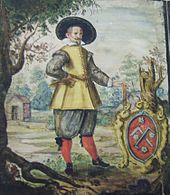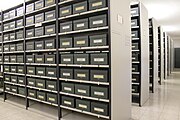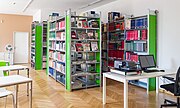City and Abbey Archives Aschaffenburg

The City and Abbey Archives Aschaffenburg is a Bavarian municipal archive . Founded as a city archive in 1931 as an independent institution , it was created in its current form in 1939, when the archive of the former collegiate foundation St. Peter and Alexander was transferred to the administration of the city of Aschaffenburg as a deposit . The archive has had this double name since then.
Since 1982 the archive has been in the Schönborner Hof in the center of the city; it had previously been in different locations (including 1931 to 1945 in Johannisburg Castle ). The building of the archive also includes the neighboring stork's nest (lecture hall) and a historic house chapel , which can be visited by appointment.
A digital archive with podcasts and digital content on the work and content of the city archive is being set up
Stocks
The collections of the monastery archive, which are also important nationwide, began in the High Middle Ages and lasted until the 19th century. In addition to several thousand documents, it also includes around 6,000 other archive materials (including files, official books , invoices and minutes). The holdings of the actual city archive as the municipal archive of the city of Aschaffenburg began at the beginning of the early modern period ; it is supplemented by numerous collections (including newspaper collections, photo collections) as well as the publicly accessible regional library for the Spessart and Bavarian Lower Main . In addition, the archives of incorporated places can be found in the city archive. As of 2017, the City and Abbey Archives made a smaller part of its holdings accessible via the German Digital Library and the Archivportal-D , although digitized archival materials are still hardly represented.
As an example of the cultural treasures of the Aschaffenburg archive, the following archive materials are listed:
- The solemn privilege of Pope Lucius III. From the monastery archives: In the regest of December 21, 1184, issued in Verona , the Pope emphasized the inviolability of the property of the monastery of St. Peter and Alexander and confirmed its freedoms. The detailed listing of the ownership of the monastery, from which several first mentions of surrounding places can be derived, is an important source for local history
- The Türckische Chronica in the country Ethnography Library, Concerning John Adelphus wrote and in 1516 Strasbourg published book with the subtitle "anefang From irem origin and regiment / bit uff zeyt this / sampt irem get and streyten / Erbärmklich to read with the Christians committed" was Acquired by the Aschaffenburg History Association in 1939 and made available to the municipal collections.
- The guild book of the Aschaffenburg shopkeepers of the guild collection: The guild book of the traders lists all shopkeepers accepted between 1544 and 1668. An outstanding feature is a portrait of the self-portrait made in 1612 by the palace builder Georg Ridinger (1568–1617), architect of the Kurmainzer Schloss Johannisburg, which lies high above the Main .
- The file on the burning of witches from 1629 : A list of all men and women executed for witchcraft in Aschaffenburg and Damm between 1628 and 1629, as well as a list of the property confiscated.
- View of Aschaffenburg from the south : This old-colored copper engraving with aquatint comes from the Heidelberg vedute painter and copperplate engraver Johann Jakob Strüdt (1773–1807) and was published around 1800 by the Mannheim art dealer of Domenico Artaria (1765–1823). The rare and first-class preserved sheet cost 16 fl. 30 kr. and was probably one of the expensive prints of its time. It is part of the graphic collection.
- A pocket calendar from 1905 : The notepad, measuring just 5.7 × 3.7 centimeters, lists the name days for each day and was produced by the Nuremberg art publisher Theodor Stroefer . It was owned by Konrad Hock from Aschaffenburg . As an example of outstanding commercial graphics , it is also part of the graphic collection.
- Posters and poster drafts from the tractor manufacturer Güldner-Motoren-Werke AG .
In 2020 the deed of a donation from Emperor Otto II to St. Peter in Aschaffenburg from 982 was rediscovered, which had been considered lost for over a hundred years.
Publications
In the series " Aschaffenburg Studies ", which has existed since 1988 and published by the City and Abbey Archives, over 20 volumes have appeared; the series is divided into:
- I. Contributions to the history of the city and
- II. Documentation .
Further publications such as special publications and reprints with contributions on the history of the city as well as the messages from the city and monastery archives , which contain articles on local history and scholarship, complement the series of publications.
literature
- Willibald Fischer: The Aschaffenburg City and Abbey Archives in the Schönborner Hof . In: Communications for archive maintenance in Bavaria 27/28 , 1981/82, pp. 71–81
Web links
- Website of the City and Abbey Archives
- Holdings of the city and monastery archives in the archive portal D
- OPAC Regional Studies Library for the Spessart and Lower Main
Individual evidence
- ^ City of Aschaffenburg, City and Abbey Archives : Homepage: Archive History. Retrieved December 4, 2019 .
- ^ Stadtarchiv-digital ; accessed on December 5, 2019
- ↑ a b City of Aschaffenburg, City and Abbey Archives: Complete overview: holdings and use. Retrieved December 4, 2019 .
- ↑ Artaria, Domenico in der Deutschen Biographie , accessed on December 1, 2017.
- ↑ Hans Kratzer: The emperor's sloppy document. In: www.sueddeutsche.de. July 11, 2020, accessed July 11, 2020 .
- ^ City of Aschaffenburg, City and Abbey Archives: Homepage: Publications. Retrieved November 16, 2017 .
Coordinates: 49 ° 58 ′ 26 " N , 9 ° 8 ′ 52" E





